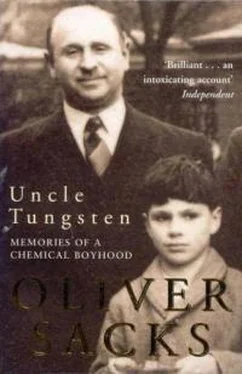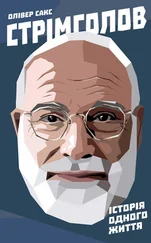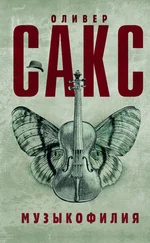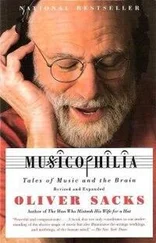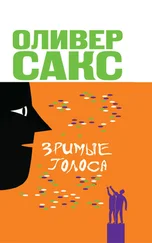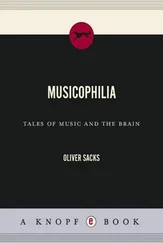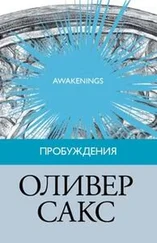Brandt handled his new element rather carelessly, and was apparently surprised to discover its lethal powers, as he wrote in a letter to Leibniz on April 30, 1679:
When in these days I had some of that very fire in my hand and did nothing more than blow on it with my breath, the fire ignited itself as God is my witness; the skin on my hand was burned truly into a hardened stone such that my children cried and declared that it was horrible to witness.
But though all the early researchers burned themselves severely with phosphorus, they also saw it as a magical substance that seemed to carry within itself the radiance of glowworms, perhaps of the moon, a secret, inexplicable radiance of its own. Leibniz, corresponding with Brandt, wondered whether the glowing light of phosphorus could be used for lighting rooms at night (this, Abe told me, was perhaps the first suggestion of using cold light for illumination).
No one was more intrigued by this than Boyle, who made detailed observations of its luminescence – how it, too, required the presence of air, how it fluctuated strangely. Boyle had already made extensive investigations of ‘luciferous’ phenomena, from glowworms to luminous wood and tainted meat, and had made careful comparisons of such ‘cold’ light with that of glowing coals (both, he found, needed air to sustain them).
On one occasion Boyle was called down from his bedchamber by his frightened and astonished servant, who reported that some meat was glowing brightly in the dark pantry. Boyle, fascinated, got up at once and commenced an investigation, which culminated in his charming paper ‘Some Observations about Shining Flesh, both of Veal and Pullet, and that without any sensible Putrefaction in those Bodies.’ (The shining was probably due to luminescent bacteria, but no such organism was known or suspected in Boyle’s time.)
* * *
Uncle Abe, too, was fascinated by such chemical luminescence, and had experimented a great deal with it as a young man, and with luciferins, the light-producing chemicals of luminous animals. He had wondered whether they could be turned to practical use, to make a really brilliant luminous paint. Chemical luminosity could indeed be dazzlingly brilliant; the only problem was that it was ephemeral, transient, by nature, disappearing as soon as the reactants were consumed – unless there could be (as with fireflies) a continued production of the luciferous chemicals. If chemistry was not the answer, then one needed some other form of energy, something that could be transformed into visible light.
Abe’s interest in luminescence had been stimulated, when he was growing up, by a luminous paint used in their old house in Leman Street – Balmain’s Luminous Paint, it was called – for painting keyholes, gas and electric fixtures, anything that had to be located in the dark. Abe found these glowing keyholes and switches wonderful, the way they glowed softly for hours after being exposed to light. This sort of phosphorescence had been discovered in the seventeenth century, by a shoemaker in Bologna who had gathered some pebbles, roasted them with charcoal, and then observed that they glowed in the dark for hours after they had been exposed to daylight. This ‘phosphorus of Bologna’, as it was called, was barium sulphide, produced by the reduction of the mineral barytes. Calcium sulphide was easier to procure – it could be made by heating oyster shells with sulphur – and this, ‘doped’ with various metals, was the basis of Balmain’s Luminous Paint. (These metals, Abe told me, added in minute amounts, ‘activated’ the calcium sulphide, and lent it different colors as well. Perfectly pure calcium sulphide, paradoxically, did not glow.)
While some substances emitted light slowly in the dark after being exposed to daylight, others glowed only while they were being illuminated. This was fluorescence (after the mineral fluorite, which often showed it). This strange luminosity had been originally discovered as early as the sixteenth century, when it was found that if a slanting beam of light was directed through tinctures of certain woods, a shimmering color might appear in its path – Newton had attributed this to ‘internal reflection.’ My father liked to demonstrate it with quinine water – tonic – which showed a faint blue in daylight and a brilliant turquoise in ultraviolet light. But whether a substance was fluorescent or phosphorescent (many were both), it required blue or violet light or daylight (which was rich in light of all wavelengths) to elicit the luminescence – red light was of no use whatever. The most effective illumination, indeed, was invisible – the ultraviolet light that lay beyond the violet end of the spectrum.
My own first experiences of fluorescence occurred with the ultraviolet lamp my father kept in the surgery – an old mercury vapor lamp with a metal reflector, which emitted a dim bluish violet light and an invisible blaze of ultraviolet. It was used to diagnose some skin diseases (certain fungi fluoresced in its light) and to treat others – though my brothers also used it for tanning.
These invisible ultraviolet rays were quite dangerous – one could be severely burned if exposed too long, and one had to wear special goggles like an aviator’s, all leather and wool, with thick lenses made of a special glass that blocked most of the ultraviolet (much of the visible, too). Even with goggles, one had to avoid looking directly at the lamp, otherwise a strange, unfocused glow appeared, due to the fluorescence of one’s eyeballs. One could see, looking at other people in the ultraviolet light, how their teeth and eyes glowed a brilliant white.
Uncle Abe’s house, a short walk from ours, was a magical place, filled with all sorts of apparatus: Geissler tubes, electromagnets, electric machines and motors, batteries, dynamos, coils of wire, X-ray tubes, Geiger counters and phosphorescent screens, and a variety of telescopes, many of which he had built with his own hands. He would take me up to his attic laboratory, on weekends especially, and once he had satisfied himself that I could handle the apparatus, he gave me the run of his phosphors and fluorescent materials, as well as the little handheld Wood’s UV lamp he used (this was much easier to deal with than the old mercury vapor UV lamp we had at home).
Abe had racks and racks of phosphors in his attic, which he would blend like an artist with his palette – the deep blue of calcium tungstate, the paler blue of magnesium tungstate, the red of yttrium compounds. Like phosphorescence, fluorescence could often be induced by ‘doping’, adding activators of various sorts, and this was one of Abe’s chief research interests, for fluorescent lights were just beginning to come into their own, and subtle phosphors were needed to produce a visible light that was soft and warm and agreeable to the eye. [54]Abe was especially attracted to the very pure and delicate colors which could be made if one added various rare earths as activators – europia, erbia, terbia. Their presence in certain minerals, he told me, even in minute quantities, lent these minerals their special fluorescence.
But there were also substances that would fluoresce even when absolutely pure, and here uranium salts (or, properly speaking, uranyl salts) were preeminent. Even if one dissolved uranyl salts in water, the solutions would be fluorescent – one part in a million was sufficient. The fluorescence could also be transferred to glass, and uranium glass or ‘canary glass’ had been very popular in Victorian and Edwardian houses (it was this which so fascinated me in the stained glass in our front door). Canary glass transmitted yellow light and was usually yellow to look through, but fluoresced a brilliant emerald green under the impact of the shorter wavelengths in daylight, so it would often appear to shimmer, shifting between green and yellow depending on the angle of illumination. And though the stained glass in our front door had been shattered by a bomb blast during the Blitz (it was replaced by an unpleasant, bobbly white glass), its colors, intensified by nostalgia perhaps, still remained preternaturally vivid in my memory – especially now that Uncle Abe had explained its secret to me. [55]
Читать дальше
